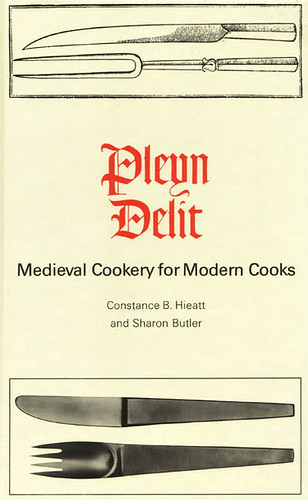
It was the 27th of March 2005, Easter Sunday, after the morning church service. I was just glancing through the cookbook shelves at the Downtown Toronto Goodwill as I usually do at thrift stores, yard sales and flea markets--all in hopes of finding that unique or old-fashioned cookbook to add to the modest collection Loy and I started when we got married a year and a half ago. Optimism wasn't high that day as soon as I saw the very paupered looking shelf, with only a very small number of cookbooks lying around. After thumbing perfunctorily through several of them, however, I caught sight of this delightful volume! It didn't take me long to decide that this purchase had to be made, and paid just Can$4 for it: what a bargain for a unique 1976 University of Toronto hardback!
This book contains more than a hundred medieval recipes, all lovingly tested and formulated (for the proportions) in the kitchen by writers Hieatt and Butler using ingredients that are for the most part easily available and familiar to modern cooks. The variety is mouthwatering: there are recipes for soppes and potages, entremets, fyshh, rostes and bakes metes of flessh, stewes, and desserts. I am not sure but wouldn't be all that surprised if this is the only book of its kind around, that combines knowledge of medieval food history with so many practical recipes.
To whet your appetite a little, here are some interesting facts about medieval food and cookery you might not have known:
- Contrary to what is commonly thought, medieval fare was mostly simple and bland (to modern tastes)--not often the rich, spicy foods drowned in outlandish sauces that appear in medieval tales
- "The most elaborate multi-course feasts had a higher proportion of roasts and plain boiled meats, served with simple 'pottages' of vegetables, than of fancier dishes." (ix)
- Roasted meats were very common; "...it is precisely because roasting is a simple, common procedure that no one would have thought it necessary to write down directions for performing it." (x)
- Recipe rolls, generally assumed to be from royal or aristocratic households, include many simple vegetable dishes.
- The order followed in English feast menus is one that is familiar to us in the respect of enjoying the dessert at the end. The plainer foods were first served, with the meal concluding with fruits, nuts, wafers, and other small delicacies. The French, however, were already tending to serve as a first course some "appetizers" of "pastries and elegant concoctions" before the more substantial part of the meal. (xi-xii)
- While the rich probably ate a fairly elaborate midday or late morning dinner as their main meal of the day, the poor (that is, most other people, like the poor widow of the Nun's Priest's Tale) might have to content themselves with a diet consisting "almost entirely of bread and milk, with bacon and a few eggs to add variety. In a period of drought Piers Plowman complained that he did not even have bacon--just some fresh cheese, the coarsest types of bread, and a supply of herbs and greens..." (xii)
- You would probably have eaten better as a servant in a well-to-do and fairly compassionate household. If the morning breakfast menu for the nurse in an early 6th century source is not far from the typical, you might expect beer and boiled mutton bones.
To check out a variation of a medieval honey almond rice pudding recipe I tried with some satisfaction, click here.
Jump back another few centuries and check out 'Around The Roman Table'.
ReplyDeletehttp://www.press.uchicago.edu/Misc/Chicago/233472.html
heheh...it's like pre-mafia Italian, I suppose :). Wifey thanks you for the link.
ReplyDeleteHi ELAINE, Where can I contact other people for a recommendation for a cooking lesson? I'm trying this site (cooking lesson). Where else could I try
ReplyDeleteMany thanks
I love finding unique cookbooks at thrift stores.
ReplyDelete